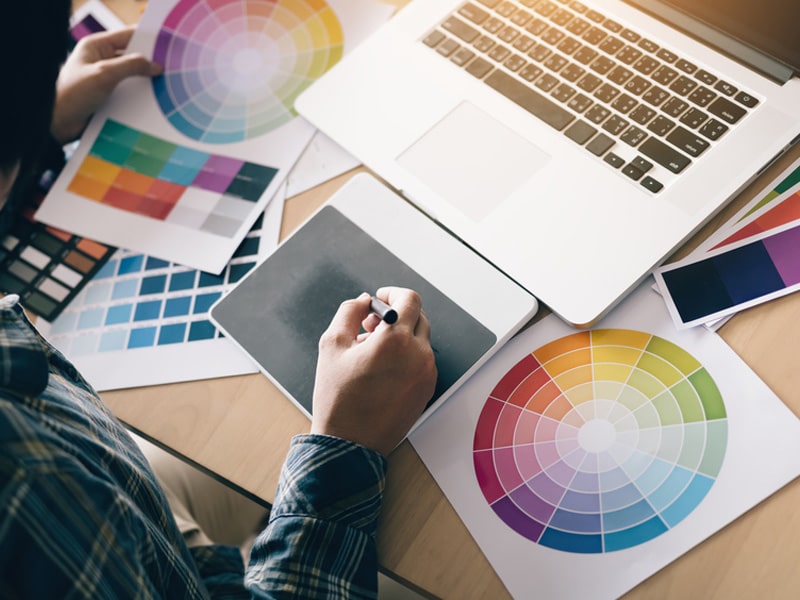
Graphic design and environmental impact
The industrial revolution at the end of the 19th century, which gave life to machines and the birth of design, has also brought pollution and wear to our planet. Our concern for the environment, global warming and the end of some basic resources is growing and therefore a new trend has been born within the design professionals: sustainable design, formerly known as eco-design or “green design”.
We can define it1 as the capacity to design objects, buildings, cities… whose principles are economic, social and environmental sustainability. It therefore covers many fields, including architecture, environmental design, urban planning, engineering, graphic design, interior design and fashion design.
Its main purpose is to produce places, products and services in a way that reduces the use of non-renewable sources and therefore minimises the negative impact of human actions on the ecosystem.
Reducing environmental impact
Sustainable graphic design is that which considers the environmental impact of products related to graphic design such as packaging, labels, graphic advertising, publications, etc. To develop an ecological design we must consider the elements used in the process of each job: different supports, labor, transportation, product use, and its disposal.
The designer can contribute to sustainable design by setting strategies that affect various aspects of his or her daily work:
Work in the studio: habits and environment.
Choice and production of material: choice of printers, services, looking for material close to the residence to avoid greater use of transport, choosing ways of getting information that require less raw materials, or a system of renting some products that reduces private consumption, etc.
Study habits and environment
Our work habits can be conducive to the preparation of an organic product. We can favour a suitable environment for this purpose, such as choosing low-consumption light bulbs, reusing paper for design tests, turning off unused equipment completely, etc.
The Australian magazine Desktop2, tells us about the different initiatives of designers to contribute to the environment by providing other more ecological solutions to customers. Anna Carlile launched the design studio Viola Ecographic Design in Melbourne, which offers sustainable solutions. It also provides other designers with a guide to useful information on paper and printing systems for achieving eco-design. Among its proposals are the following:
Check with your printer which format you can use to make the most of the sheet in the imposition and thus save paper.
Make sure of the type of gas emission in the printing process: inks, varnishes, adhesives, cleaning solutions, etc.
Check with the printer the option of printing without photolithography, directly on the plate.
Choose vegetable inks with uncoated paper whenever possible.
Avoid metallic and fluorescent inks as they contain heavy metals.

Choose water-based varnishes, rather than UV or laminated varnishes.
Check that the printing company you work with recycles and uses some kind of energy-saving system.
Check that your work can be easily recycled, that it does not contain any non-recyclable materials or effects.
Choose paper that has been made from trees from plantations created for this purpose. Make sure it is FSC certified.
Printers, inks and papers
Inks
We can achieve sustainable design by choosing printers that consume little energy and whose consumable products are as environmentally friendly as possible. Today, there are printing systems that not only respect nature, but also guarantee the highest quality in design.
Conventional inks are based on petroleum and are mixed with solvents and alcohol base, which transmit toxic gases into the atmosphere, harmful to health and the ecosystem. Alternatively, there are machines that develop ecological solutions, such as alcohol-free printing and waterless offset.3 Another option is to use natural oil-based inks, which do not use mineral oils.
The advantage of these inks is that they remain fresh in the inkwell, offer good absorption and leave less residue. On the other hand, designers are increasingly using varnish finishes, so we should also demand that the printers we work with use either water-based or ammonia and amine-free varnishes.
Paper
The manufacture of standard paper uses large amounts of energy, virgin vegetable fibre and produces pollution. If we choose a suitable paper or support, we can also contribute to the conservation of nature.
An ecological paper will be one whose manufacture avoids environmental impact, for which the use and consumption of natural resources and energy are considered; the elimination of waste, the production of noise and odours during the extraction of raw materials, etc.
In other words, ecological paper does not have to be recycled, since it is also taken into account that the method of production is respectful of the environment.
In any case, we should not think that quality work cannot be done with recycled paper, since the great advances in recycling technology already allow us to choose high-performance waste paper for the most complex applications. The best thing is to choose a paper certified by some organism whose labelling informs us that it is ecological, and classifies it according to its degree of aggression to the environment.
There are labels developed in different countries that allow us to distinguish whether the paper we are going to choose is ecological, recycled, elemental chlorine free (ECF) or totally chlorine free (TCF), such as the European Ecological Label, whose ecological criteria can be consulted on the Web.
